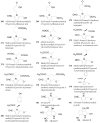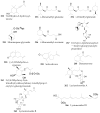Systematic Review of Chemical Constituents in the Genus Lycium (Solanaceae)
- PMID: 28629116
- PMCID: PMC6152755
- DOI: 10.3390/molecules22060911
Systematic Review of Chemical Constituents in the Genus Lycium (Solanaceae)
Abstract
The Lycium genus is widely used as a traditional Chinese medicine and functional food. Many of the chemical constituents of the genus Lycium were reported previously. In this review, in addition to the polysaccharides, we have enumerated 355 chemical constituents and nutrients, including 22 glycerogalactolipids, 29 phenylpropanoids, 10 coumarins, 13 lignans, 32 flavonoids, 37 amides, 72 alkaloids, four anthraquinones, 32 organic acids, 39 terpenoids, 57 sterols, steroids, and their derivatives, five peptides and three other constituents. This comprehensive study could lay the foundation for further research on the Lycium genus.
Keywords: Lycii cortex; Lycium genus; chemical constituents; goji berry.
Conflict of interest statement
The authors declare no conflict of interest.
Figures


































References
-
- Zhang Z.Y., Lu A.M., D‘Arcy W.G. Flora of China. Volume 17: Verbenaceae through Solanaceae. Science Press; Beijing, China: Missouri Botanical Garden Press; St. Louis, MO, USA: 1994. pp. 301–304.
-
- Chinese Pharmacopoeia Commission . Pharmacopoeia of the People’s Republic of China Part I. Chemical Industry Press; Beijing, China: 2015.
Publication types
MeSH terms
Substances
LinkOut - more resources
Full Text Sources
Other Literature Sources

